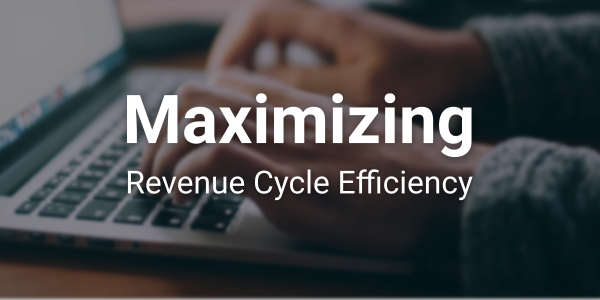
Aug 15, 2022 | MedCycle Solutions, Partner
By Ann Knutson, CPC-A
The healthcare revenue cycle includes all administrative and clinical functions that involve capturing, managing, and collecting the provider’s/facilities revenue. The cycle includes three distinct parts of the practice/facility that’s referred to as the front-end, middle, and back end. Unfortunately, most of the time there is little coordination between the three areas which can lead to more claim denials and lost revenue for the practice/facility. Therefore, adding a revenue integrity team to your practice/facility dramatically improves operational efficiency, compliance measures, and reimbursement rates. Members of the team must have extensive knowledge of and be familiar with the complete healthcare revenue cycle.
In order to foster collaboration between all three areas of a practice/facility that affect the revenue cycle, specific training needs to be implemented for staff, along with coding and documentation education for providers.
Specific staff training includes:
- Keeping up to date on billing requirements, such as coding guidelines, billing regulations, and insurance payer policies.
- Reimbursement updates, such as data showing rate of reimbursement vs. denials/rejections.
- Key performance indicators, such as data regarding common billing or coding errors leading to claim denials and rejections.
- Job expectations, such as all billing employees must know every aspect and function of their job in detail.
Provider education involves:
- Chart reviews to verify proper documentation.
- Quarterly meetings regarding coding guidelines, payer rules, and the importance of medical necessity.
Furthermore, creating templates and tip sheets for billers, coders, and providers improves operational efficiencies, clean claim submission, and proper provider documentation. It also decreases claim denials and puts everyone in the practice/facility on the same page.
In addition, the collaboration between coders and the accounts receivable team is crucial to improving reimbursement rates, the outcome of claim appeals, and compliance with regulations. It can also help to reduce the number of claim denials and rejections. Plus, medical coders are able to share their expertise regarding regulations and proper coding with the Accounts Receivable (AR) team members. This helps the AR team with reconciling claim rejections and denials along with properly submitting appeals. On the other hand, the AR team can inform coders of the current codes or coding combinations that are being rejected or denied by payers. With this vital information, coders can make the required coding and billing changes as they enter the charges and submit the claims. This can greatly improve the rate of clean claims submission. (AAPC, 2021)
Therefore, it’s in the best interest of a practice/facility to implement a revenue cycle management team that is familiar with the entire revenue cycle, fosters collaboration between all areas of the practice/facility and providers, and maintains open communication between all departments in order to maximize revenue cycle efficiency and reimbursement. For assistance with maximizing your revenue cycle efficiency, please contact us at MedCycle Solutions.
For more information about maximizing revenue cycle efficiency, please visit www.aapc.com.
Ann Knutson, CPC-A is an Accounts Receivable Specialist at MedCycle Solutions, which provides Revenue Cycle Management, Credentialing, Outsourced Coding, and Consulting Services to a number of healthcare providers in a variety of specialties. To find out more about MedCycle Solutions services please visit www.MedCycleSolutions.com.

Jul 3, 2022 | Partner, Trizetto Partner Solutions
It’s safe to say that healthcare practitioners are well aware of the importance of credentialing. Beyond the legalities required of practicing physicians, credentials are needed for a practice’s revenue cycle to function properly. If providers aren’t enrolled with payers, they can’t receive payment for submitted claims. It’s as simple as that.
New and existing providers are required to maintain credentials and it’s not an easy process, even for the most well-oiled office. In order to take on the most patients and collect optimal revenue, practices also need to accept a wide array of payers. In fact, there has been a 5 percent uptick in providers enrolled with 10-20 payers, according to VerityStream’s 2018 Provider Enrollment Survey. Gaining enrollment with these payers involves verifying qualifications in order to accept patients, submit claims and ensure a steady stream of cash. Administrators need to collect the educational history of providers, fill out forms and submit the applications. It sounds easy enough, right?
Think again. There are hours of administrative work needed and a high risk for human error, with any hiccup in the process likely causing delays. It’s been said that up to 85% of credentialing applications are incomplete, which could cause delayed billing, lost revenue or even audits.
When it comes to credentialing, time is money. A 2016 survey by Merritt Hawkins found that a non-credentialed doctor was losing approximately $6,600 a day. Multiply that by the total amount of physicians in a given practice, and the potential losses are staggering.
Credentialing is a necessary evil, so do you handle in house or outsource? That’s the million dollar question. Utilizing current staff resources sounds like the easy solution, but does your organization have a dedicated employee to focus on your credentialing needs? Probably not. Chances are, this employee is pulled in many directions and isn’t able to dedicate time solely to credentialing. And if you do plan to handle the process with current staff, are your employees well-versed in all payers and their processes? Factor in learning curves or potential staff turnover and the time associated with training new employees and the not-so obvious financial costs quickly add up.
So how does the average practice streamline the process and ensure that credentials are gained as painlessly as possible? The old adage “you get what you pay for” could easily apply to this scenario. Hiring an outside resource means you are essentially paying for expertise and efficiency, which will save time and money in the long run. Why wouldn’t you want to utilize expert resources with in-depth knowledge of payer and state nuances? However, before making a decision, you need to know how much your practice could save by using a third party. Knowledge is power and having an accurate picture of your potential revenue is the first step to determining the best option for your organization.
Access the credentialing ROI calculator from TriZetto Provider Solutions, a Cognizant Company, to receive an estimate of potential revenue savings. Discover the hidden costs associated with the credentialing process and see just how much revenue your practice could be leaving on the table. You’ll gain enrollments quickly and accurately, keep employee satisfaction levels high (since they won’t be burdened by the process) and ultimately, increase revenue.
Don’t allow the complicated payer credentialing and enrollment process to be a burden on your practice. The credentialing experts at TriZetto Provider Solutions have experience working with various payers and providers of all backgrounds. Our team will collect and submit information in a timely manner and perform all necessary follow-up tasks. Let us lighten your load so you can focus on patient care and growing your practice.
[Contribution by TriZetto Provider Solutions Editorial Team]

Oct 28, 2021 | EZClaim, Medical Billing Software Blog
If you’re thinking of investing in medical billing software, there’s no better person to give you the answers you need than Chelsea Graven, a revenue cycle director for Alert Medical Alarms. With over ten years in the medical billing industry, she’s been in numerous roles including billing and claims submissions. A longtime customer and champion of EZClaim since 2013, Chelsea has referred the software to many other partners because she knows firsthand not only how simple it is to use, but how effective the software is.
Recently, we found time to interview Chelsea about her start in the industry, why she continues to recommend EZClaim, and her advice on anyone starting out in medical billing.
EZCLAIM: Working with EZClaim’s medical billing software platform, what role does their software impact your work?
GRAVEN: “The company I currently work for was originally either submitting paper claims or billing through portals. EZClaim has allowed us to transition to electronic billing and it cuts the amount of time we spend in provider portals or filling out those forms. I would say seventy-five percent of the workload has been cut using EZClaim. Previously, it took one person three weeks to bill 6,000 claims. Now, we are billing 7,000 claims in a matter of minutes just by submitting and using the features within EZClaim, such as the recurring claim option.”
EZCLAIM: If you were going to share something with your colleagues about EZClaim, what would it be?
GRAVEN: “How spot on the name ‘EZClaim’ is. It’s exactly what it’s called, EASY. Other software programs do not accommodate the simple recurring billing that we need. EZClaim is the only software I have used that does that and makes it easy. Of all the billing software platforms I have used, EZClaim is the simplest to use and the most user-friendly.”
EZCLAIM: What would you say are some strengths needed to be an effective medical biller?
GRAVEN: “Analyzing, troubleshooting, and resolving. There is a lot of that involved. You must be able to troubleshoot and independently find resolutions in order to be effective at billing. I think EzClaim has customized reporting capabilities that allow the companies to better follow current trends that they are seeing in claims, denials, and payments. Tracking the trends is what will lead to the troubleshooting, analyzing, and resolving of any issues, having customizable reporting makes all the difference to successful billers. You can’t fix something if you don’t know it’s wrong, EzClaim reporting brings all of that to the biller, so you don’t have to go looking for problems/solutions on top of your daily billing processes.”
EZCLAIM: Do you have any advice for anyone who is starting out in the medical billing industry?
GRAVEN: “EZClaim is my go-to for anyone who is doing medical billing and is wanting to learn and get into the industry because it is the simplest software to use. EZClaim makes it easy to grasp the electronic billing end-to-end process without feeling overwhelmed by the complexity of the software. I would say for anyone starting out the first thing I would do is find an electronic billing solution and a clearinghouse.”
EZCLAIM: Why did you get into the medical billing industry?
GRAVEN: “I actually fell into this industry by default. I was working on private pay collections for a company and at the time the state of Illinois in 2010 transitioned to manage care programs, and no one was really prepared for that. I was then asked to take on the role of billing manager. It grew so large that doing HCFA 1500 forms was not efficient, so I started looking for electronic billing solutions. What I enjoy most about the billing industry is closing the claims entirely. Getting that amount to zero dollars. Most people wouldn’t say it’s the money coming in, but for me, it’s the gratification for the end-to-end process of the revenue cycle. It’s all about getting the receivables closed.”
EZCLAIM: Final thoughts?
GRAVEN: “With EZClaim, the value is beyond just the software. Yes, it’s easy to work with, but the IT team and all the people involved make the experience favorable.”
[ The above answers were paraphrased as closely as possible to the original answers given by Chelsea Graven on October 22nd, 2021. ]
ABOUT EZCLAIM:
As a medical billing expert, EZClaim can help the medical practice improve its revenues since it is a medical billing and scheduling software company. EZClaim provides a best-in-class product, with correspondingly exceptional service and support. Combined, EZClaim helps improve medical billing revenues. To learn more, visit EZClaim’s website, email them, or call them today at 877.650.0904.

Jul 29, 2021 | Medical Billing Software Blog, Partner, Waystar
As patients return to doctor’s offices and health systems around the country, healthcare organizations find themselves in uncharted waters, with a greater need than ever to make data-driven decisions that grow revenue. Per a recent report from KLAS, 63% of hospitals found themselves struggling with real-time data analytics.
It should come as no surprise then that investments in new analytics tech and training are on the rise. According to a report from the Society of Actuaries (SOA), 42% of surveyed healthcare executives reported an improvement in patient satisfaction since implementing predictive analytics, while 39% said they had cut costs. Since 2011, over $39B has been invested in digital health tech, including $7.48B in 2019 alone. It’s estimated that roughly 20% of that has been funneled into the development of technology-focused on managing health records and analytics. Furthermore, some models have estimated improving available data collection and analysis tech could save the healthcare industry roughly 25% of its total costs.
The question is, what can you do to unlock that potential within your own organization? There’s a deep well of data that each revenue cycle feeds into, which if properly analyzed, can help organizations operate at their most efficient and effective. Here are the four stages of data analytics workflows that are key to developing those actionable insights.
1. A trigger, or the point in your revenue cycle that sets up the call for deeper analysis
2. Interpretation of data to determine root causes and identify appropriate next steps
3. Intervention to improve specific metrics
4. Tracking of said metrics to chart success in achieving desired outcomes
Let’s examine what a successful version of each stage looks like.
1. Trigger
The trigger occurs when you notice something that needs further investigation. With the right analytics tool, you can easily access all of your key performance indicators, financial goals, and more, providing the visibility you need into your rev cycle. When something looks amiss or needs improving, you can drill down to the level that shows what’s really going on.
2. Interpretation
Even a wealth of data amounts to nothing without an efficient way to process and communicate key takeaways. You’ll need to equip your team with access to concise reports, smart visualizations, and relevant historical data in order to get them to the insights that drive action.
3. Intervention
Now is the time to take action. Intervention is ultimately tied directly to your ability to drill down into the data underlying problematic areas of your revenue cycle and clearly communicate takeaways with your team. Success at this stage depends on designing a plan based on your best understanding of underlying issues and the most effective way to address them.
4. Tracking
Your intervention plan is built on KPIs that naturally intertwine with the way you measure success across your revenue cycle. With proper implementation and tracking, running with the analytics cycle can become a simple addition to your everyday workflow. More than delivering on your initial goals, the true power of analytics is the ability to deliver repeat value on your initial investment.
A strong analytics solution does more than deliver a more fully developed picture of your rev cycle performance. It provides actionable business intelligence, cuts down on time between analysis and action, and lessens the strain on your IT department.
Beyond the actionable internal insights it can provide, analytics is also a key tool for helping you benchmark performance in comparison to peers in the industry. And with the right analytics solution, competitive analysis is a simple task, using automation that reviews customizable benchmarks for a tailored review of the claim, payment, and denial performance.
Looking for a truly comprehensive analytics solution to help improve performance and enhance your benchmarking capabilities? Find out how Waystar can help you harness the power of your data through analytics. Visit Waystar.com
Heading to AMBA in October? Visit Waystar and EZClaim while you’re there! Stay tuned for more event details.
ABOUT EZCLAIM:
As a medical billing expert, EZClaim can help the medical practice improve its revenues since it is a medical billing and scheduling software company. EZClaim provides a best-in-class product, with correspondingly exceptional service and support. Combined, EZClaim helps improve medical billing revenues. To learn more, visit EZClaim’s website, email them, or call them today at 877.650.0904.
[ Contribution from the marketing team at WayStar ]

Jul 26, 2021 | Partner, Trizetto Partner Solutions
Medicare is the largest payer for most practitioners, so it’s important that providers maintain current credentials. Medicare requires providers to revalidate every five years to verify credentials and ensure they meet Medicare qualifications. Providers must confirm or update information including the legal entity name, physical address, phone, fax, national provider identifiers, employer identification number, and board certifications and licenses if applicable.
While typically a straightforward process, if not completed correctly and on time, providers will be terminated from the program and required to reapply. Until a new application is processed and approved, which can take anywhere from 90-120 days, reimbursements will stop, disrupting the revenue cycle.
Occasionally, providers may receive off-cycle revalidation requests. These are typically triggered when anomalies are identified such as billing rates that are significantly higher than other providers in the same geography, billing for services not rendered, or billing patients for services that Medicare doesn’t allow.
To comply with Medicare revalidation requirements, providers need to know their revalidation schedule and make sure applications and supporting documentation are submitted through Medicare’s PECOS online application portal. Revalidation dates cannot be extended, so it’s important they’re submitted on time. Using a third party to navigate the nuances of Medicare revalidation and PECOS removes the burden from provider staff and ensures accurate and timely filing.
TriZetto Provider Solutions (TPS) offers an end-to-end credentialing service that includes continuous payer follow-up and insight into enrollment status. Our dedicated team takes provider data, verifies it for accuracy, and submits credentials for revalidation through PECOS. All Medicare-participating providers are subject to revalidation, and mistakes made before or during the process can result in loss of eligibility and other penalties.
Having nearly four decades of experience working with payers and providers, the TPS credentialing experts understand the importance of maintaining current credentials. Contact us to learn more about our Medicare revalidation services.
ABOUT EZCLAIM:
As a medical billing expert, EZClaim can help the medical practice improve its revenues since it is a medical billing and scheduling software company. EZClaim provides a best-in-class product, with correspondingly exceptional service and support. Combined, EZClaim helps improve medical billing revenues. To learn more, visit EZClaim’s website, email them, or call them today at 877.650.0904.






